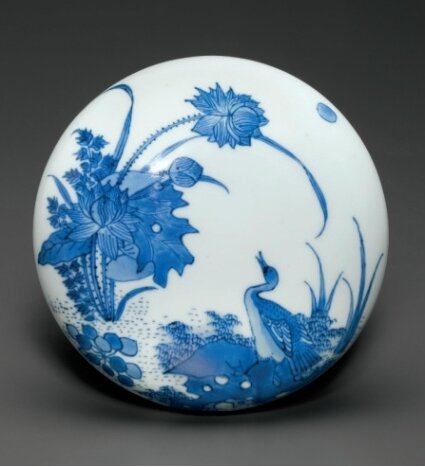A blue and white ovoid jar and cover, Shunzhi period, circa 1640-1650
Lot 3513. A blue and white ovoid jar and cover, Shunzhi period, circa 1640-1650. Estimate $40,000 – $60,000. Price realised USD 106,250. Photo Christie’s Image Ltd 2015
The jar, of ovoid form with short neck, is decorated in vibrant tones of cobalt blue with a continuous scene of a lotus pond in which various acquatic birds gather, including a heron nestled within lotus blossoms, two geese in flight above and a third perched on a rock, and an alert kingfisher perched on a long blade of millet with curling leaves. The scene is set beneath a carved scroll band around the shoulders and a band of lappets on the neck. The domed cover is decorated with a fourth goose perched on a rock beside lotus plants. 11 ¼ in. (28.4 cm.) high
Provenance: S. Marchant & Son, Ltd., London, 2000.
Collection of Julia and John Curtis.
Literature: Michael Butler, Julia B. Curtis, and Stephen Little, Shunzhi Porcelain: Treasures from an Unknown Reign, 1644- 1661,Alexandria, VA, 2002, p. 47, fig. 7
Exhibited: Honolulu Academy of Arts, Honolulu, Hawaii, Shunzhi Porcelain: Treasures from an Unknown Reign, 1644-1661, 2 May – 8 September 2002.
The Trammell & Margaret Crow Collection of Asian Art, Dallas, Texas, Shunzhi Porcelain: Treasures from an Unknown Reign, 1644-1661, 3 October 2002 – 5 January 2003.
University of Virginia Art Museum, Charlottesville, Virginia, Shunzhi Porcelain: Treasures from an Unknown Reign, 1644-1661, 25 January – 23 March 2003.
Notes: In her comments on this jar and cover in Shunzhi Porcelain: Treasures from an Unknown Reign, 1644-1661,Alexandria, VA, 2002, Dr. Julia Curtis compares this piece with a vase from the collection of Daisy Lion-Goldschmidt, pointing out the shared qualities of the two that are typical of Shunzhi-period porcelains. Besides the violet tones of the cobalt blue, the green-tinted glaze, and the similar incised borders and bands of pointed leaves, she notes that “The spatial composition of the two vessels is also typical of the Shunzhi era; the decoration makes copious use of negative space on the unpainted surfaces of the vessels. »
CHRISTIE’S. AN ERA OF INSPIRATION: 17TH-CENTURY CHINESE PORCELAINS FROM THE COLLECTION OF JULIA AND JOHN CURTIS, 16 March 2015,New York, Rockefeller Plaza

/https%3A%2F%2Fprofilepics.canalblog.com%2Fprofilepics%2F1%2F0%2F100183.jpg)
/https%3A%2F%2Fstorage.canalblog.com%2F03%2F02%2F119589%2F96711876_o.jpg)
/https%3A%2F%2Fstorage.canalblog.com%2F11%2F31%2F119589%2F94773502_o.jpg)
/https%3A%2F%2Fstorage.canalblog.com%2F20%2F83%2F119589%2F94772815_o.jpg)
/https%3A%2F%2Fstorage.canalblog.com%2F26%2F72%2F119589%2F75604929_o.jpg)
/https%3A%2F%2Fstorage.canalblog.com%2F59%2F60%2F119589%2F26458628_o.jpg)





/image%2F1371349%2F20240416%2Fob_2a8420_437713933-1652609748842371-16764302136.jpg)
/image%2F1371349%2F20240414%2Fob_83ee65_2024-nyr-22642-0954-000-a-blue-and-whi.jpg)
/image%2F1371349%2F20240414%2Fob_15808c_2024-nyr-22642-0953-000-a-blue-and-whi.jpg)
/image%2F1371349%2F20240414%2Fob_e54295_2024-nyr-22642-0952-000-a-rare-blue-an.jpg)